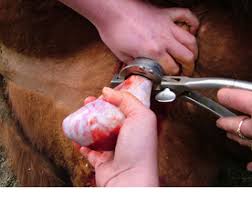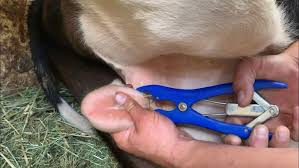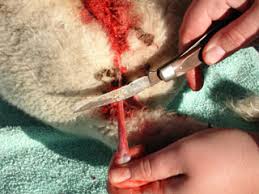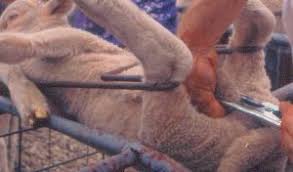Castration is an important management practice for sheep and goat farmers to maintain control of their breeding programs and successfully carry out breed improvement.
Castration involves the removal or destruction of the testes, epididymis, and a portion of each spermatic cord in a ram or buck. In most cases, non-breeding males and males not slaughtered at a young age should be castrated.
Traditionally, some farmers do not castrate animals, allowing both males and females to run together. This results in inferior males mating with females, passing on undesirable traits, and producing young stock that are not very productive. There are also other reasons for castrating sheep and goats:
Methods of Castration
There are three commonly used methods of castration for sheep and goats: the Burdizzo method, the banding or elastrator method, and the knife (surgical) method.
The different methods are more suitable for animals of different sizes and ages. For example, the elastrator method is more suitable for very young animals. It is important to match the castration method to the size and age of the animal.
Read Also: Introduction to Tree Crops of Economic, Social, and Cultural Importance in Nigeria
1. The Burdizzo Emasculatome Method

The following steps outline the castration of sheep and goats using the Burdizzo:
Step 1: The animal should be properly restrained by an assistant. The operator grasps the scrotum in one hand and manipulates the testes down into the scrotum. They then locate the two spermatic cords between their fingers and push one cord over to one side of the scrotum. This is the first cord to be crushed.
Step 2: Place the jaws of the Burdizzo onto the upper scrotum, leaving the rudimentary teats above the crushing point. Do not crush the septum or tissue between the testicles. Instead, focus on one side of the scrotum at a time.
Step 3: Clamp the Burdizzo over the cord on the side of the scrotum you are working on first. You can generally hear a clicking sound as the cord is crushed. Leave the instrument closed for 20 to 25 seconds, or the time it takes to count from one to 25.
The spermatic cord can be elusive when trying to crush it. Ensure that you feel it within the jaws of the Burdizzo before and after closing the jaws. You can tug on the cord to check if it feels ruptured.
Step 4: Release the Burdizzo, move it lower to a new site about 1 cm closer to the testicles, and close it again to ensure the cord is fully crushed. A site below the first crush is chosen to minimize acute pain from a second crush.
Step 5: Locate the cord on the other side of the scrotum and position the Burdizzo over it. Close the Burdizzo and repeat the process as done with the first cord.
Step 6: When finished, you may see a mark on each side of the scrotum. The animal may be sore and move slowly for about a day. Encourage it to move around. Initially, the scrotum may swell slightly, but the testicles will gradually shrink over the next few weeks, leaving a small scrotal sac.
Read Also: Preparation and Management of Tree Crop Nursery
2. The Banding or Elastrator Method

This method involves cutting off the blood supply to the testicles using a heavy-duty rubber band or ring. Materials needed include an elastrator and castrating bands.
An elastrator is a special applicator that stretches a heavy-duty rubber band and applies it to the neck of the scrotum. The scrotum and testes will fall off in two to four weeks, depending on the size of the testicles.
This method causes some stress to the animal due to the pain and discomfort caused by the constricting band, especially for 10 to 15 minutes after the elastrator band is applied. Follow these procedures to castrate lambs or kids using the elastrator method:
Procedure:
Do not use rings older than 12 months to avoid breakage and ensure a tight fit. The rings must be strong enough to cut off blood flow in the arteries as well as the veins. If not, the scrotum will swell. Restrain the animal as described above.
Place a rubber ring over the prongs of the elastrator. Hold the elastrator with the prongs facing up. Close the handles to open the band. Pass the scrotum and testicles through the expanded hole of the band. Position it as close to the animal’s body as possible, taking care not to place the band over the rudimentary teats or involve the penis.
Release the elastrator, displacing the ring from the prongs and positioning the band. The band will return to its original shape, cutting off circulation to the testicles and eventually causing all of the tissue below the band to die and fall off.
Check to ensure both testicles are still in the tip of the scrotum and that the ring is placed properly. If not, cut the ring with scissors and repeat the procedure.
Administer an injection of tetanus antitoxin. Even though this is a bloodless procedure, the tetanus organism can enter through the irritated tissue around the rubber ring. Check daily to ensure the rubber band is still around the neck of the scrotum and watch for signs of infection.
3. The Knife Method

The testicles may be surgically removed. Materials needed include a clean and sterile sharp knife, a one-sided razor blade or scalpel, warm water, disinfectant (iodine can be used), syringes, tetanus antitoxin, and a fly control spray designed for open wounds.
Bucks and rams older than six months may need to be sedated prior to castration using a knife.
To perform a knife castration, follow these procedures after the animal is restrained by an assistant. Begin by washing your hands and instruments (knife or scalpel) thoroughly with soap and water, then disinfect them.
Next, wash the scrotum thoroughly and disinfect it. Avoid exciting the lambs, kids, or calves before or immediately after castration, as this can increase bleeding.
Push the testicles high up into the scrotum. Cut off the bottom one-third of the scrotal sac with a cut parallel to the ground. The testes should now be visible. Manipulate each testis separately to the open end of the scrotum. It may sometimes be necessary to push on the abdomen if a testicle has been pulled deep into the abdominal cavity.
This article has discussed the different methods of castration in farm animals. You should now be able to identify the different equipment used for castration and understand the procedures involved.
Do you have any questions, suggestions, or contributions? If so, please feel free to use the comment box below to share your thoughts. We also encourage you to kindly share this information with others who might benefit from it. Since we can’t reach everyone at once, we truly appreciate your help in spreading the word. Thank you so much for your support and for sharing!
Read Also: 4 Steps to help an Orange Tree Produce Sweet Oranges
Frequently Asked Questions
We will update this section soon.

